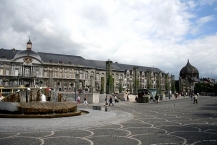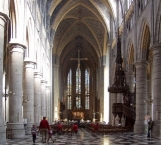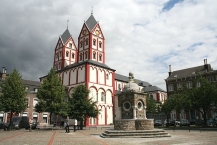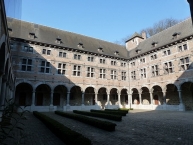Cycle Route L'Ardennaise
No. of cycle route RV7
Actions
![]()
Please wait - map data are loading
Added on 25 Nov 2011,
on 25 Nov 2020
Actions
Cycle route metrics
Total distance in km
209
Information about rights to the gps-track data | |
|---|---|
Rights owner | OpenStreetMap and Contributors + biroto-Redaktion (biroto.eu) |
Rights characteristic / license | Contains information from OpenStreetMap, which is made available here under the Open Database License(ODbL) |
Link to the description of the license | |
GPX file taken from | |
GPX file uploaded | by biroto-Redaktion on 25 Nov 2020
|
Track points in total
3.390
Track points per km (avg)
16
Start/endpoint
Start location
Bouillon, Wallonia, BE (224 m NHN)
End location
Visé, Wallonia, BE (60 m NHN)
Beds4Cyclists, worth visiting and infrastructure
Name and address
Latitude / Longitude
Phone
Fax
Mobile
Type of accommodation
Rating for cyclists
Route km
Dist. to route
Elevation
142 km
0,1 km
113 m
151 km
0,1 km
99 m
183 km
0,6 km
63 m
184 km
2,0 km
131 m
185 km
0,4 km
64 m




Liège (German: Lüttich, Dutch: Luik) is the largest city of Wallonia, the French-speaking part of Belgium, and the capital city of the namesake province. Located at the foot of Ardennes on the river Meuse, it has been a prominent urban centre since the Middle Ages, but really blossomed during the industrial revolution, when it grew to become Belgium's third-largest metropolis, after Brussels and Antwerp. Thanks to its strategic position, Liège still enjoys relative affluence and economic importance, in contrast to its fellow Wallon cities farther south.
Despite its size and location in-between some of the most-visited cities in Europe, Liège sees very little tourist traffic. Those who find it along their itinerary might be surprised to find the purported industrial city to be quite green, with wide boulevards, an interesting, if a bit disorderly, mix of architecture from different periods, much greenery and picturesque riverbanks and hillsides. There are also quite a few museums and other points of interest, enough for at least a busy day trip.
Understand
Liège has been an important city since the early Middle Ages. It was the capital of the Principality (prince-bishopric) of Liège, which remained an independent state until the French Revolution (around 1789). In the 19th century it became an early centre of industrialism. Today it is a large city of 200,000 inhabitants, with a total 750,000 in its metropolitan area. The city has an important Italian community, making up 5% of the population.
The central area of Liège presents itself as a rather interesting mix of a historic town centre (dotted with a few extremely brutalist buildings from the 1960s and 70s), a rather elegant new town with wide boulevards, tall apartment buildings (some Art Deco), narrow street with small businesses, a few pretty parks, and a few interesting shopping arcades. The outskirts of Liège consist mainly of 2 very distinctive areas: large industrial complexes sprawling on the river's bank in the north and the south (with the cities of Seraing and Herstal) and working-class areas in the east and the west with mainly spare green neighborhood for healthy people.
Liège is located just at the beginning of the Ardennes, which makes the landscape of the south very different than the rest of the city, with high hills and abundant forests (Sart-tilman and beyond).
See
Historic Centre
⊙Place St. Lambert is a major square in the centre, where a number of key sights may be found. It was the site of Gothic Cathedral of Our Lady and St (Cathédrale Notre-Dame-et-Saint-Lambert), representation of religious power, torn down at the start of the 19th century after the revolution of Liège and today memorialized by metal columns and a design traced on the ground. At Place Saint Lambert 9-17, admire the neo-classic façades, dating from the late 19th and early 20th centuries.
- ⊙Palace of the Prince-Bishops. Composed of the Palace of Justice (classic façade at Place Saint Lambert 18) and the Provincial Palace (lateral neo-gothic façade at place Notger 2). This palace is the heart of the city, and represents the political power of the old Prince-Bishops of Liège.
- ⊙archéoforum, ☎ +32 4 2509370. Open 10AM-6PM from Tuesday to Saturday, 11AM-6PM on Sunday, closed on Monday. an underground archeological site with the remains of the three (successive) cathedrals on the site, as well as a building from Roman times. €5.50 (Guided); €3.00 (Un-Guided).
- ⊙Hôtel de ville de Liège (La Violette), place du Marché, 2. Perron, and houses along the market square. The town hall, is an elegant classic building. It was built in 1714, during reconstruction after the French attacks in 1691. It can be visited on rare occasions only, except for the "salle des pas perdus" - "room of lost steps" which is freely accessible. The houses on the square, with their charming blue stone and brick faces, date from the same period. The Perron, symbol of the city's freedom, is at the center of the square above the fountain that acts as its support. The perron is one of the symbols of the city and was used to render justice.
Other sights in the historic city centre include:
- ⊙Hôtel d’Ansembourg, Feronstrée 114, ☎ +32 4 2219402. now a museum, is worth visiting for the well-preserved original interior €3,80.
- ⊙Curtius Palace (Grand Curtius), quai de Maestricht 13, ☎ +32 4 2219404. This imposing 8-story building from the start of the 17th century was the store of a rich arms merchant, art and history collections
- ⊙Hôtel de Hayme de Bomal, quai de Maestricht 8 and rue Feronstrée 122. was an official building under French rule and twice welcomed Napoleon.
- ⊙Saint Barthélémy Church, rue Saint Barthélémy 2, ☎ +32 4 2234998. Open 10-12AM and 2-5PM from Monday to Saturday, 2-5PM Sundays. was the last of 7 "collégiales liégeoises" to be built, near the end of the 11th century. Recently renovated, it is home to the masterwork of the Liège goldsmiths from the Middle Ages: the baptismal fonts from the old parish church of the cathedral. €1,25.
- ⊙Museum of Wallonian Life (Musée de la Vie Wallonne), Cour des Mineurs, ☎ +32 4 2379040. is an ethnological mueseum hosted in an old convent
- ⊙Museum of Religious Art, rue Mère Dieu 1, ☎ +32 4 2214225. Open 11AM-6PM Tu-Sa, 11AM-4PM Su, closed Mo. will be integrated into the future Museum Grand Curtius, but can now be visited separately €3,80.
- ⊙Montagne de Bueren (Mountain of Bueren and the slopes of the Citadel). Climb the imposing staircase of 373 steps framed by small houses and gardens, or opt for the smaller streets and stairways leading up to the Citadel's slopes. From the top, you'll have a lovely view of the city, from the Palace roofs to the ancient watchtower.
- ⊙La Cathédrale Saint Paul de Liège (St. Paul's Cathedral, Liège), Place de la Cathédrale 1, ☎ +32 4 2326131.
- ⊙Collégiale Saint-Denis de Liège (Church of St. Denis), Rue Cathédrale, 6. former fortified collegiate church with 12th century tower
- streets Hors Château and En Feronstrée. are worth a visit for the architecture of the large villas and more modest houses, most dating to the 18th century
- streets Fond Saint Servais, Pierreuse and du Péry. are typically quaint and lead up to the remains of the old citadel, with an ancient well, a monument commemorating the Second World War, and in particular a superb view over the city.
Outremeuse
On the opposite bank of the river, the Outremeuse district has few memorable buildings, notably the Rue Roture, but a welcoming atmosphere. Also the most-visited museum complex in Liège and Wallonia, comprised of the Aquarium, the House of Science, and the Zoology Museum, all housed in a neo-classic University building.
- The main buildings of interest in the district are:
- Convent "des Récollets", rue Georges Simenon 2, 4, 9-13.
- ⊙Saint Nicolas Church, rue Fosse-aux-raines 7. open everyday 8AM to 12AM.
- Sainte Barbe" hospice, place Ste Barbe.
- stable of the Fonck barracks, boulevard de la Constitution.
- Bavière hospital, boulevard de la Constitution.
- Destenay school, boulevard Saucy 16.
- Physiology Institute, place Delcourt 17.
- ⊙Grétry Museum, Rue des Récollets 34, ☎ +32 4 3431610. 2PM-4PM Tu&Fr, 10AM-12PM Su.
- ⊙Museum of Tchantchès, rue Surlet 56, ☎ +32 4 3427575. 2-4PM Su except July, Tu&Th. dedicated to the city mascot who is also the main character for the local marrionnette theaters
- ⊙Maison de la Science, Quai Edouard Van Beneden 22, ☎ +32 4 3665015.
- ⊙Aquarium-Muséum de Liège, Quai Edouard Van Beneden 22, ☎ +32 4 3665021.
Information about copyright | |
|---|---|
Rights characteristic / license | by-sa: CREATIVE COMMONS Attribution-ShareAlike |
Link to the description of the license | |
Input taken over from: |
Wikivoyage contributors, 'Liège', Wikivoyage, The FREE worldwide travel guide that anyone can edit, 7 May 2016, 05:18 UTC, <https://en.wikivoyage.org/w/index.php?title=Li%C3%A8ge&oldid=2988171> [accessed 11 November 2016] |
taken over / edited on | 11 Nov 2016 - 28 Aug 2018
|
taken over / edited by |
|
![]()
